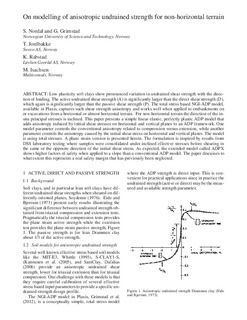On modelling of anisotropic undrained strength for non-horizontal terrain
Chapter
Accepted version

Åpne
Permanent lenke
http://hdl.handle.net/11250/2582399Utgivelsesdato
2018Metadata
Vis full innførselSamlinger
Originalversjon
10.1201/9781351003629Sammendrag
Low plasticity soft clays show pronounced variation in undrained shear strength with the direction of loading. The active undrained shear strength (A) is significantly larger than the direct shear strength (D), which again is significantly larger than the passive shear strength (P). The total stress based NGI-ADP model, available in Plaxis, captures such shear strength anisotropy and works well when applied to embankments on or excavations from a horizontal or almost horizontal terrain. For non-horizontal terrain the direction of the insitu principal stresses is inclined. This paper presents a simple linear elastic, perfectly plastic ADP model that adds anisotropy induced by initial shear stresses on horizontal and vertical planes to an ADP framework. One model parameter controls the conventional anisotropy related to compression versus extension, while another parameter controls the anisotropy caused by the initial shear stress on horizontal and vertical planes. The model is using total stresses. A plane strain version is presented herein. The formulation is inspired by results from DSS laboratory testing where samples were consolidated under inclined effective stresses before shearing in the same or the opposite direction of the initial shear stress. As expected, the extended model called ADPX shows higher factors of safety when applied to a slope than a conventional ADP model. The paper discusses to what extent this represents a real safety margin that has previously been neglected.